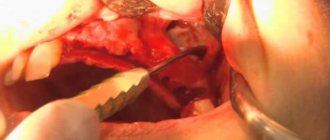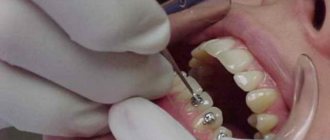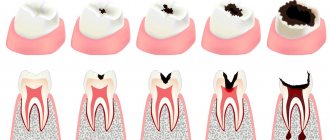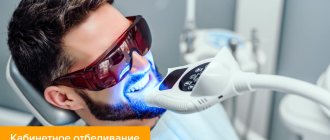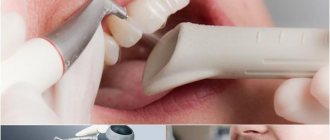2459
Some patients visit dentists because they have a tooth that has already formed in the oral cavity, but for a number of reasons has not erupted.
In most cases, its position does not cause any discomfort, but at the same time others think that the person does not have a tooth in its usual place.
Less common, but possible, is the appearance of purulent processes that can lead to serious consequences.
To prevent future problems, medicine suggests performing orthodontic traction on the problem unit.
The essence of the technique
When pulling a tooth, it can not only be moved vertically, but also tilted in the desired direction.
This is possible due to a number of anatomical features of the structure of the root part of the organ, as well as due to the use of a certain force. Experts strive for the appearance of so-called pressure zones, which ensure the occurrence of histological changes.
It is necessary to understand that this procedure cannot be carried out in several sessions. As practice shows, it takes several months to finally restore the normal physiological position.
Although there are exceptions for some patients. One of the main factors determining the speed of this process is the age of the patient.
Duration of treatment
The time it will take to pull out is difficult to predict exactly. It depends on the following characteristics:
- Patient's age . As a rule, the younger the patient, the faster all changes in the area of the dentofacial apparatus occur.
- Clinical picture . If the stretching is carried out for a dystopic element, then it will require more time to turn and give the correct orientation.
Usually the course lasts from six months to two years, without taking into account the preliminary correction of the dentition at the preparatory stage.
Indications and contraindications
Indications include the following:
- genetic features of development;
- early process of changing milk units;
- the course of vitamin deficiency;
- unnatural jaw development;
- the presence of somatic weakness;
- carrying out prosthetics or removal of problem units without following the established schedule.
The procedure is not carried out if there is no free space to move the element of the jaw row, there are no neighbors near the damaged unit, or when the intracanal pin is difficult to install.
Find out reviews from patients after orthognathic surgery about the complexity and pain of the procedure.
Come here to find out if you can get braces if you have crowns.
At this address https://orto-info.ru/sistemyi-vyiravnivaniya-zubov/breketyi/kak-mozhno-tselovatsya-otkrovenno-o-sokrovennom.html we will tell you how to kiss with braces.
Signs that after tooth extraction the root system remains in the gums
If medical manipulations were performed correctly, normally there should be no fragments of the dental unit in the socket. Due to unprofessionalism and mistakes of the dentist and for other reasons, after some time it may be discovered that there are pieces of hard tissue in the gums. What symptoms can you tell by:
- persistent pain and throbbing sensation for several weeks;
- swelling, redness of the mucous membranes;
- increased body temperature (intermittent or persistent fever);
- slow wound healing, bleeding.
If such symptoms appear, you should visit a dental clinic as soon as possible. The specialist will take a picture and give an opinion on whether complications have arisen after the extraction.
Basics of conducting
To carry out the procedure in question, diagnostics and preparation are required, after which the problem tooth is pulled out.
Once the process is completed, the patient will have to wait for some time, periodically checking with a dentist.
Identification of the defect location
The main objective of the presented procedure is to bring the defect site to an optimal position, located above the alveolar gum or ridge. This way you can restore the damaged element while maintaining the normal state of the periodontium.
It takes two to three visits to move a unit. First, the doctor carefully dissects the periodontal fibers and restores the normal position of the root. Next, the periodontal fibers take root in the resulting position.
Diagnostics
The essence of the diagnosis comes down to taking an x-ray, after which you can understand whether retention is present, at what angle the impacted element is cut, and in what sector of eruption it is located at the time of inspection.
Computed tomography allows you to most accurately determine the location and further possibility of carrying out the procedure.
It should also be noted that if the diagnostic results reveal the presence of an impacted canine tooth resting on the root of neighboring units, the patient will have to prepare for the loss of all of them.
The reason for this is the possibility of eating the roots of neighboring units that are located at an unnatural angle.
Preparation
The specialist inserts a pin into the inner part of the root, the end of which is equipped with a hook. Next, you need to install a wire “crossbar” on the adjacent teeth.
Using a special elastic band, the root is “suspended” to the resulting crossbar. Thanks to the traction that appears, the tooth is pulled out from the inner space of the gum.
Sometimes patients are embarrassed by the results of the preparation. To hide all defects during the recovery period, specialists create a composite veneer, which covers the treated area.
Carrying out
The procedure for carrying out such an operation includes two stages. At the first stage, a corresponding place is created in the jaw row, and at the second stage, the impacted element is brought into the desired position.
In most cases, the operation is performed with mandatory exposure of the crown.
The technique includes four main stages:
- The crown of the problematic element is completely exposed.
- A lock is installed on adjacent units, including the defective one.
- Using elastic traction, the impacted canine is pulled out.
- The canine is further extended using an elastic arch.
Let's figure out together what you can't eat with braces on your teeth and how to eat properly.
In this publication, read what an initial orthodontic consultation for children includes.
Here https://orto-info.ru/ortodonticheskoe-lechenie/osnovnoy-period/brekety-i-karies.html all the most important things about the causes of caries from braces.
Traction of an impacted tooth
Diagnostics
Again, the diagnostic procedure is carried out using computed tomography. It allows you to check at what angle the defective area is located and what the next steps will be for comprehensive treatment.
On average, diagnosis takes from 5 to 10 minutes, depending on what kind of computed tomography is performed.
Preparation
Before the procedure is carried out, it is necessary to completely cure all teeth. The technique is also applicable to molars, but in this case the possibility of furcation exposure cannot be excluded. This, in turn, can reduce the lifespan of the restored unit.
Immediately before the operation, the specialist must administer local anesthesia. Surgeries are possible only if the patient’s condition allows them to begin work (the area of the oral cavity being treated is fully prepared for surgery).
Carrying out
The essence of the technique is as follows:
- Using orthodontic forceps.
- Installation of a pin with a special loop before cementing it in a specially designated channel.
- Installation of a bracket that is completely adapted to the hard tissues located in the adjacent space.
- Cementing the pin in the canal with subsequent fixation of the bracket to the elements of the jaw row located nearby.
- Installation of elastic fiber.
- Installation of a fixed elastic cord followed by fibrotomy.
- Relocation of the problematic root, seven days later.
Complications
Both before and after the operation, the doctor must familiarize the patient with how to behave correctly for the fastest and highest quality recovery.
When moving, the tooth has to move for a long time, turning in parallel by a certain number of degrees.
If all instructions are followed correctly, the process will not take long. On the other hand, neglecting the rules and forcing events leads to potential complications, for example, bone tissue will begin to resorb, which will negatively affect the roots.
It is possible that in the future it will be necessary to completely remove both the problematic element and the neighboring ones, since they are in close contact with the deformed area with their base.
The video presents one of the orthodontic tooth traction techniques.
Diagnostics
The generally accepted method for determining retention is to examine the jaw using X-rays. This can be teleradiography (an overview image in frontal and lateral projections) or orthoanthomography (an image in which the bones of the facial skeleton are rotated in one plane). TRG and panoramic tomography make it possible to accurately determine the presence of retention, location, completeness and angle of eruption of an abnormal tooth. If necessary, the doctor may refer the patient for a CT scan.
Tooth extraction is carried out after an x-ray
Advantages and disadvantages of technology
When performing orthodontic tooth traction, it is possible to prevent preparations that are located in the vicinity. The need to create removable dentures/bridges is also avoided.
This is of great importance, especially when adjacent units are covered with a high-quality metal-ceramic crown, which could be removed for subsequent bridge production. The client does not have to pay extra money.
It is also worth noting that the original contour of the nearby soft tissue is completely preserved, which is very important in terms of aesthetics.
Therefore, the main candidates for this procedure are dental office visitors who do not want to completely remove the root and replace it with an implant.
The disadvantage of the technique is that the gum, the area of which is located in the impacted tooth, begins its recession.
If the periodontal junction is damaged when the crown is exposed, the root that needs to be moved will have to be significantly exposed. This, in turn, is considered a blunder.
Why is retention dangerous?
A partially erupted tooth is covered with a “hood” of adjacent tissues, under which food debris collects and colonies of pathogenic microflora develop, which can provoke purulent inflammation. With complete retention, another problem arises: a tooth embedded in the tissues constantly affects its “neighbor,” causing it to move from its correct position. The situation may sooner or later become more complicated:
- caries of adjacent teeth and resorption of their roots;
- malocclusion, crowded teeth and other dental anomalies;
- pulpitis and periodontitis;
- periodontal cyst;
- pericoronitis (inflammation of the gingival “hood”) and its complication, periostitis;
- purulent lymphadenitis;
- inflammation of the trigeminal nerve;
- abscess and phlegmon.
Therefore, when diagnosing retention, the patient is offered the optimal way to solve the problem.
What can be done about an impacted tooth?
- According to indications, based on the general clinical situation, removal of an impacted wisdom tooth may be recommended (especially for patients undergoing treatment with braces for an abnormal bite).
- In some cases, not accompanied by obvious problems, when removal is not necessary, the doctor will suggest observing the tooth.
- Healthy impacted incisors and canines located in the smile zone, subject to certain conditions, can be “pulled out” from the dental tissues and returned to the dentition.
Expected effect
The tooth is pulled out using a specially installed system. Although the procedure occurs without any pain, you should prepare in advance for the fact that you will have to spend a lot of time.
As practice shows, it takes an average of 3-4 months to restore milk units, while for older patients it can last up to nine months.
When determining the amount of time required for treatment, the complexity of the individual case and the current condition of the oral cavity as a whole are taken into account. With the help of a chain, the doctor completely extends the element with every millimeter.
The end result is complete extension of the tooth. The best option is when a third party is shown the results of treatment without telling him about the fact of the procedure, and at the same time he does not understand what the differences are between a normal and an extraordinary situation.
In other words, the result is of high quality only when the tooth is fully extended to return to its normal physiological position.
The operating time of the elongated element may also vary depending on the condition it was in at the time of treatment.
It is extremely important to prevent the development of any diseases, as well as to cope with existing pathologies. Otherwise, the patient risks encountering complications in the form of infection in the treated area and nearby units.
In terms of time of use, the treated molar will be no different from the rest. The main thing is to adhere to the rules of personal hygiene and constantly monitor the appearance of signs of the disease.
But this will be prevented by regular visits to the dentist. One way or another, you will still have to regularly go to the dental office, because doctors need to fully control the recovery process.
An impacted tooth interferes with dental implantation in a 60-year-old patient
Problem: during diagnostics before dental implantation, an impacted tooth (canine) was discovered in the bones of the upper jaw.
Solution: in one operation under sedation, an impacted tooth (canine) was removed, 4 teeth that could not be treated, bone grafting was performed in the area of the impacted tooth to restore bone volume, and Astra Tech dental implants were installed.
How to remove a tooth root without an apex
Stages of treatment:
- the use of anesthesia selected individually, taking into account contraindications and characteristics of the body;
- separation of the circular ligament from the neck and edge of the alveolus (in the absence of inflammatory processes of soft tissues);
- cutting the gums, drilling out bone structures to access the root part;
- direct removal with forceps or an elevator, use of a drill (if necessary);
- treatment of the hole with a special composition to accelerate healing.
In the absence of a crown, the procedure becomes more complicated and cannot be performed at home. An experienced doctor will remove all the fragments along with the base in an average of half an hour.
Tooth root removal under anesthesia
In most situations, local anesthesia is used. However, in cases where we are talking about the extraction of “eights”, or in cases of intolerance to the components of the drugs, or a pathological fear of dental treatment, general anesthesia is resorted to. Throughout the entire procedure, the person sleeps, so he does not feel pain or psychological discomfort.
Despite the tangible advantages, this technique has a significant drawback. Its use can lead to serious problems with the heart, brain and other internal organs and systems. Some patients have difficulty recovering from anesthesia and experience nausea, headaches and other symptoms.
In modern dentistry, a more gentle method is used - sedation. The person relaxes, but is conscious and can interact with doctors. There is no stress or pain.
